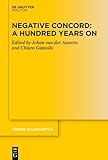Negative Concord: A Hundred Years On / ed. by Johan van der Auwera, Chiara Gianollo.
Material type: TextSeries: Trends in Linguistics. Studies and Monographs [TiLSM] ; 385Publisher: Berlin ; Boston : De Gruyter Mouton, [2024]Copyright date: 2025Description: 1 online resource (VI, 346 p.)Content type:
TextSeries: Trends in Linguistics. Studies and Monographs [TiLSM] ; 385Publisher: Berlin ; Boston : De Gruyter Mouton, [2024]Copyright date: 2025Description: 1 online resource (VI, 346 p.)Content type: - 9783111200866
- 9783111202983
- 9783111202273
- 415
- online - DeGruyter
- Issued also in print.
| Item type | Current library | Call number | URL | Status | Notes | Barcode | |
|---|---|---|---|---|---|---|---|
 eBook
eBook
|
Biblioteca "Angelicum" Pont. Univ. S.Tommaso d'Aquino Nuvola online | online - DeGruyter (Browse shelf(Opens below)) | Online access | Not for loan (Accesso limitato) | Accesso per gli utenti autorizzati / Access for authorized users | (dgr)9783111202273 |
Frontmatter -- Contents -- Introduction -- Section 1: General theoretical issues -- Negative concord: the first 133 years -- Negindefinites and negative concord: concepts, terms and analyses -- Negative concord and TAM: a new perspective -- Non-strict negative concord: a correlate of focus movement? -- The universal force of (strict) negative concord -- N-words: in defence of wide scope. A view from Romanian -- Section 2: Perspectives on variation -- Negative concord in Medieval Greek: lexical asymmetry and the role of correlative negation -- What does the linear position of negative concord items tell us about their properties? -- Grammar or error? Non-compositional (expletive/paratactic) negation in Dutch sentences with zonder ‘without’ -- Two negatives in Tyneside English questions: negative concord or double negation? -- Less formal and more rebellious — An experiment on the social meaning of negative concord in American English -- Subject index -- Language index -- Name index
restricted access online access with authorization star
http://purl.org/coar/access_right/c_16ec
The concept of ‘negative concord’ refers to the seemingly multiple exponence of semantically single negation as in You ain’t seen nothing yet. This book takes stock of what has been achieved since the notion was introduced in 1922 by Otto Jespersen and sets the agenda for future research, with an eye towards increased cross-fertilization between theoretical perspectives and methodological tools. Major issues include (i) How can formal and typological approaches complement each other in uncovering and accounting for cross-linguistic variation? (ii) How can corpus work steer theoretical analyses? (iii) What is the contribution of diachronic research to the theoretical debates?
Issued also in print.
Mode of access: Internet via World Wide Web.
In English.
Description based on online resource; title from PDF title page (publisher's Web site, viewed 20. Nov 2024)


